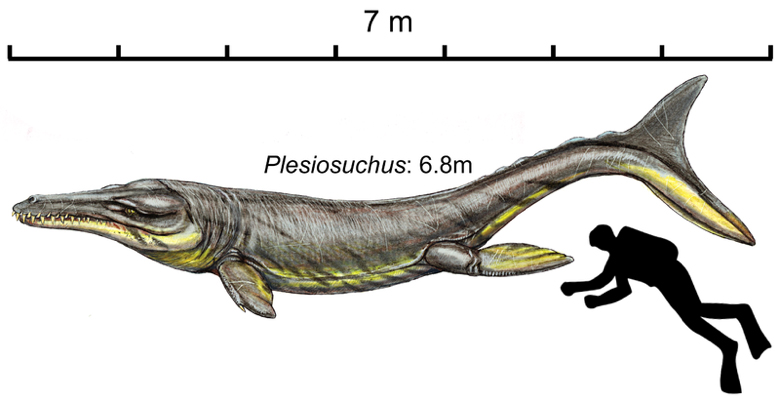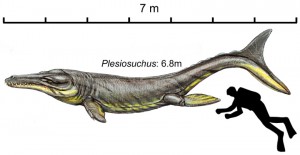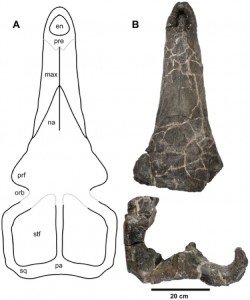
Plesiosuchus
NarrativesExtinct marine crocodile of the Late Jurassic
Plesiosuchus is an extinct genus of marine crocodile from the Late Jurassic. Fossils of this marine reptile have been found in England and possibly, Spain. It has only one species, Plesiosuchus manselii.
Plesiosuchus has a maximum body length of 6.8 m, making it the second largest Jurassic marine crocodile (after Machimosaurus, a gharial-like marine crocodile with a body length of 9.3 m). A partial skull, jaw, teeth, few vertebrae, etc. represent the fossil material of this creature.
Plesiosuchus was once known as a species of Dakosaurus, D. manselii, before it was moved into its own genus, as mentioned above.
Partial skull of Plesiosuchus. (Source: http://www.plosone.org/article/info%3Adoi%2F10.1371%2Fjournal.pone.0044985)
The fossils of Plesiosuchus was found on the coast of Dorset along with fossils of other huge marine reptiles. Not only Dorset, fossil material referred to Plesiosuchus can be found on the beaches of Asturias, Spain, represented only by a tooth crown.
Plesiosuchus is closely related to the hypercarnivorous marine croc Dakosaurus, which swam across the Jurassic seas of Europe and South America.
The name Plesiosuchus comes from the Greek language and it means “near crocodile”.

Size of Plesiosuchus compared to a human. (Source: Young MT, Brusatte SL, de Andrade MB, Desojo JB, Beatty BL, et al. (2012) The Cranial Osteology and Feeding Ecology of the Metriorhynchid Crocodylomorph Genera Dakosaurus and Plesiosuchus from the Late Jurassic of Europe. PLoS ONE 7(9): e44985. doi:10.1371/journal.pone.0044985)
Plesiosuchus’ diet mostly consisted of other marine reptiles. Its close relative Dakosaurus has a more generalist diet (meaning it could eat anything it could get hold of). Large, sharp and well-compressed teeth were the evidence of its diet (Dakosaurus also had sharp and well-compressed teeth).
Sometimes it lived together with Dakosaurus, working together to hunt for prey in their territories (and they never got into a fight due to niche partitioning (one creature specializes on eating a certain diet, while the other gets its own), thus there is no competition between those two).
In fact, Plesiosuchus had an analogous behavior with modern killer whales, since it attacks any marine creature (killer whales also attack their own prey in packs, but Plesiosuchus hunted alone).
Factfile:
Name: Plesiosuchus
Meaning: “near-crocodile”
Named by: Richard Owen (1884)
Time period: Late Jurassic
Locations: Southern England and Northern Spain
Species: manselii
Size: Maximum body length is 6.8 m.
Diet: Large fish, other marine reptiles
Fossil representations: Partial skull, jaw, snout, vertebrae and teeth
